Statement on Monetary Policy – February 2018 6. Economic Outlook
The International Economy
Global economic conditions strengthened further over 2017. GDP growth increased across a broad range of economies and world GDP growth reached its highest rate since 2011. The near-term outlook for growth in Australia's major trading partners is a little stronger than at the time of the November Statement, reflecting stronger-than-expected data for some economies and the expected boost to demand from US tax cuts (Graph 6.1). Some indicators are suggesting that wage and inflationary pressures are picking up. While markets have increased their expectations for a withdrawal of monetary policy accommodation, the pace of this withdrawal is still expected to be gradual and the stance of monetary policy is expected to remain accommodative over the forecast period.
The improved outlook for major trading partner growth is being supported by a recovery in investment in the major advanced economies and the high-income economies in Asia. There have also been some tentative signs of an increase in labour productivity growth, which had slowed significantly over the past decade. All these factors should contribute to the productive capacity of these economies.
Growth in China is expected to moderate a little over the coming year. Fiscal policy and solid growth in financing continues to support growth, but weaker property market conditions and environment-related restrictions are expected to have a dampening effect. Policy efforts to rein in ‘shadow banking’ activities and achieve a more environmentally sustainable pattern of growth are also expected to slow growth over the next year or so, while reducing risks to financial stability. In the longer term, growth in China is expected to slow gradually, reflecting structural factors such as the declining working-age population. The east Asian economies (other than China and Japan) are expected to grow at around potential over the forecast period, supported by the improvement in the global economy and an expected pick-up in domestic demand.
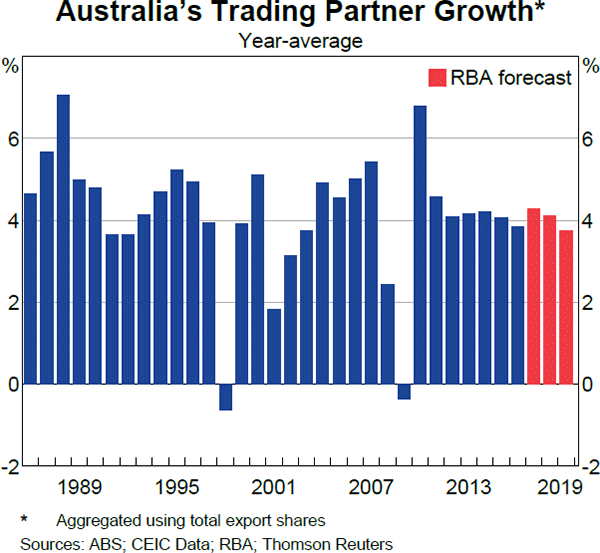
GDP growth in the major advanced economies is expected to remain above potential growth over the next couple of years. This is largely because monetary policies are expected to remain accommodative (although in some cases, less so) and fiscal policies are expected to be more expansionary. The recently enacted tax changes in the United States should provide fiscal stimulus in 2018 and 2019 and lead to higher US consumption and investment growth over the next couple of years. In 2017, the euro area's economic expansion gained momentum, which is likely to continue in the near term. The Japanese economy has benefited from the pick-up in global demand and investment growth is expected to remain strong in part to address labour shortages.
Although still low, wage growth has increased in some of the major advanced economies that are around full employment. Wage pressures are expected to increase gradually as spare capacity in these economies' labour markets declines further. This should put upward pressure on inflation in the next couple of years.
Chinese steel demand is expected to weaken over the forecast period and further increases in low-cost supply of bulk commodities are in the pipeline. Consequently, the terms of trade are expected to decline, but to remain above their trough in early 2016 (Graph 6.2). In the near term, however, some volatility in the terms of trade is expected following recent disruptions to Australian coal supply and ongoing uncertainty about the effects of the Chinese authorities' environmental restrictions on steel production.
Domestic Activity
The forecasts for domestic output growth are similar to those presented in the November Statement (Graph 6.3; Table 6.1). September quarter GDP growth was in line with expectations, though there were some differences at the component level; weak consumption growth was offset by strong growth in business investment and public demand. Domestic demand growth looks to have continued at a broadly similar pace in the December quarter; timely indicators point to a recovery of consumption growth in the December quarter. However, exports are likely to have declined because of temporary disruptions at key coal export ports and the effect of unfavourable weather on rural exports.
The domestic forecasts are based on a number of technical assumptions. The cash rate is assumed to move broadly in line with market expectations, although this does not imply a commitment to any particular path for policy by the Reserve Bank Board. The exchange rate and oil prices are assumed to remain at their current levels. This implies an exchange rate that is 2 per cent lower on a trade-weighted basis than assumed in the November Statement and a US dollar price of Brent crude oil that is about 2 per cent higher. The population aged over 15 years is assumed to grow by 1.6 per cent over both 2018 and 2019.
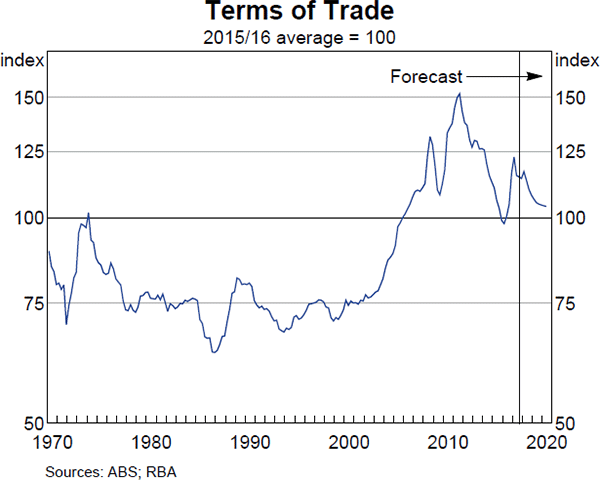
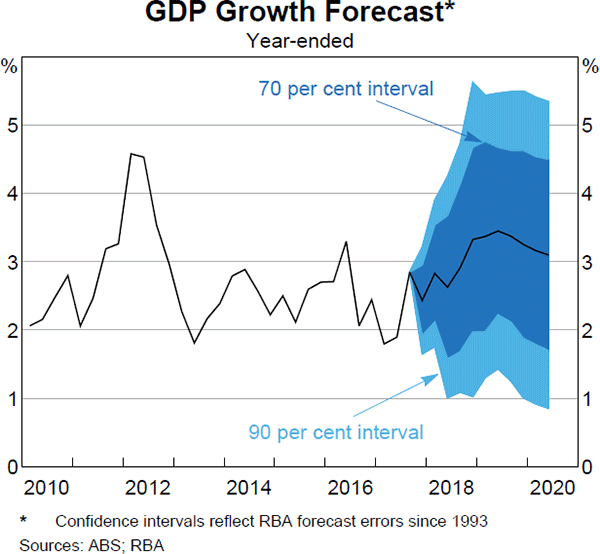
| Year-ended | ||||||
|---|---|---|---|---|---|---|
| Dec 2017 | Jun 2018 | Dec 2018 | Jun 2019 | Dec 2019 | Jun 2020 | |
| GDP growth | 2½ | 2¾ | 3¼ | 3½ | 3¼ | 3 |
| Unemployment rate(b) | 5.5 | 5¼ | 5¼ | 5¼ | 5¼ | 5¼ |
| CPI inflation | 1.9 | 2 | 2¼ | 2¼ | 2¼ | 2¼ |
| Underlying inflation | 1¾ | 1¾ | 1¾ | 2 | 2 | 2¼ |
| Year-average | ||||||
| 2017 | 2017/18 | 2018 | 2018/19 | 2019 | 2019/20 | |
| GDP growth | 2¼ | 2¾ | 3 | 3¼ | 3¼ | 3¼ |
|
(a) Technical assumptions include A$ at US$0.78, TWI at 64, Brent crude oil price at US$64 per barrel; shaded regions are historical data Sources: ABS; RBA |
||||||
GDP growth is forecast to strengthen over 2018 and 2019 as the drag from mining investment comes to an end and accommodative monetary policy provides ongoing support for growth in household income and consumption, and non-mining business investment. The implementation of the National Disability Insurance Scheme (NDIS) and public infrastructure investment are expected to help sustain growth in public demand. Growth is expected to slow a little towards the end of the forecast period because liquefied natural gas (LNG) production will have reached its steady state and LNG exports are not expected to contribute much to growth after 2019. Although year-ended growth is forecast to be above potential by the end of the year, the economy is not expected to encounter broad-based capacity constraints for some time.
One of the important factors behind the gradual pick-up in GDP growth is that most of the decline in mining investment has now passed. Combined with ongoing growth in mining exports, this means that the mining sector should make a positive contribution to GDP growth over the next few years. The level of mining investment is expected to stabilise in the second half of 2018: while there are very few new large projects scheduled to commence and the construction phase of the remaining large LNG projects is close to completion, major mining firms will need to undertake investment in coming years if they are to maintain their existing productive capacity (although most of this activity is expected to be after 2020). As additional LNG production comes on line over 2018 and 2019, LNG exports are expected to contribute around ¼ percentage point to GDP growth per year. Iron ore export volumes are expected to increase a little further over the next couple of years as productivity improvements from Australia's major producers yield some increases in production.
The recent momentum in non-mining business investment is expected to continue, supported by an increase in infrastructure activity and the diminishing impact of falling mining investment on other sectors of the economy. Industry liaison suggests that positive flow-on effects from public sector investment are likely to support growth in machinery and equipment investment in coming years. Building approvals data and expectations from the ABS capital expenditure (Capex) survey for 2017/18 both suggest that there will be some strength in non-residential construction in the near term. Whether this strength carries over into 2018/19 will become clearer at the beginning of March, when the next Capex survey is released.
Public demand is also expected to provide impetus to growth for some time. In addition to the positive spillovers from strong public infrastructure investment (See ‘Box C: Spillovers from Public Investment’), growth in public consumption is being supported by the rollout of the NDIS and is forecast to be faster than overall GDP growth.
Household consumption growth is forecast to pick up a little but to a rate that is lower than the average rate seen prior to the onset of the financial crisis. The outlook for household income growth continues to represent a significant uncertainty for the consumption forecasts. Dwelling investment is expected to remain at high levels for some time, supported by a significant pipeline of work still to be done. Even so, dwelling investment is not likely to contribute to GDP growth over the forecast period.
Consistent with the overall GDP growth profile, there has been little change to the employment growth profile since the November Statement. Although employment growth was surprisingly strong throughout 2017, it is expected to moderate over the next few years. Even so, employment growth is expected to remain stronger than growth of the working-age population and support household income and consumer spending. The unemployment rate is forecast to decline gradually to 5¼ per cent as GDP growth picks up pace (Graph 6.4). The profile for the unemployment rate is slightly lower than forecast in the November Statement, reflecting a lower starting point and the information provided by near-term leading indicators. However, the forecasts suggest that there will still be some spare capacity in the labour market at the end of the forecast period. The speed and extent to which the unemployment rate declines over time will depend on the behaviour of the participation rate and average hours worked. The participation rate has risen quite sharply over the past year as some people delayed retirement and improved labour market conditions encouraged others to join the labour force. The participation rate is expected to increase a little further over the next few years. As discussed below, the uncertainty around the projections for the participation rate translates directly into uncertainty about the unemployment rate and the degree of spare capacity in the labour market.
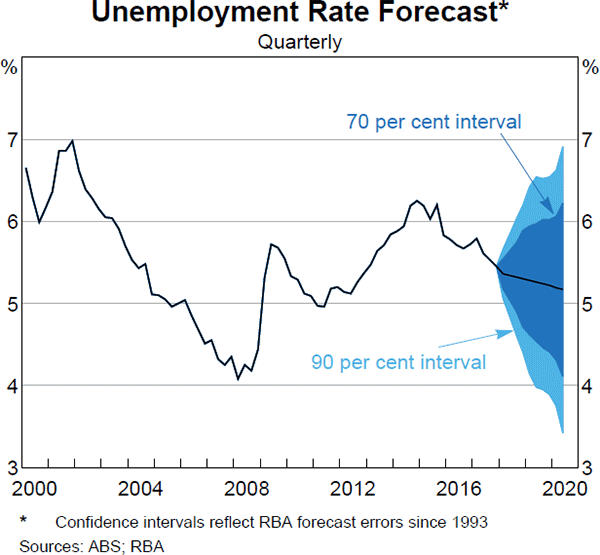
The September quarter wage data were slightly weaker than expected, although there were temporary factors that may have weighed on wage outcomes in the quarter and are expected to have boosted wage growth slightly in the December quarter. Wage growth is expected to pick up gradually over the year ahead as spare capacity in the labour market declines and the adjustment following the mining boom ends. Implicit in this forecast of a pick-up in wage growth is the assumption that any effects of structural factors that might be currently weighing on wage growth will gradually lessen. The rollover to new enterprise bargaining agreements with lower wage growth than current agreements will exert downward pressure on overall wage growth for the next couple of years. The size of new wage claims, both in enterprise and individual agreements, will provide an indication of any recovery in wage growth.
Inflation
The December quarter inflation data were in line with forecasts in the November Statement. As such, there is little change to the outlook for underlying inflation, apart from a marginal increase to reflect the expectation that spare capacity in the labour market will decline a bit further than previously forecast (Graph 6.5). World export price inflation is likely to pick up a little, which will support tradables prices. Underlying inflation is expected to increase to around 2 per cent in early 2019 and to 2¼ per cent by mid 2020.
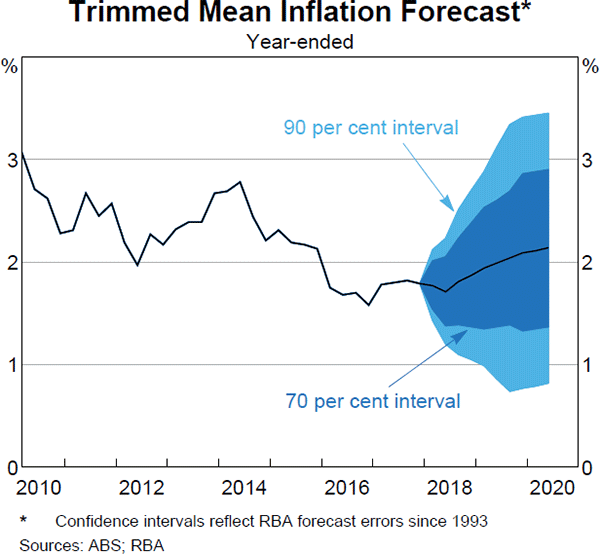
The gradual pick-up in inflation reflects the decline in spare capacity in the economy as GDP growth picks up to be above potential and the economy moves closer to full employment. This is expected to see labour costs put more upward pressure on inflation. On the other hand, there are a number of factors that are likely to weigh on inflation. The combination of weak discretionary consumer spending and continued retail competition has seen a decline in consumer durable prices over recent years. While consumption growth is forecast to pick up this year, it is expected that the arrival of new entrants in the retail sector will continue to put downward pressure on some retail prices over the next few years.
Headline inflation is expected to be around 2¼ per cent from late 2018. In the near term, higher utility prices in Victoria are likely to boost headline inflation in the March quarter. Further out, scheduled increases in the tobacco excise will also add to headline inflation.
The key areas of uncertainty for the inflation outlook are around how labour market conditions will translate into wage growth (see below), the behaviour of inflation expectations, and exchange rate movements. It is also uncertain how long the factors that are contributing to higher utility price inflation will take to resolve.
Key Uncertainties
There are a number of key uncertainties in relation to the forecasts. They are similar to those discussed in the November Statement. For the global economy, investment growth could have more momentum and positive spillovers to activity could be larger than currently forecast. Some risks, such as escalating geopolitical tensions and increased global trade protectionism, have the potential to derail the current economic expansion, as do the longstanding financial stability risks associated with high levels of debt in the Chinese economy.
Domestically, a key source of uncertainty for the forecasts continues to be the outlook for the labour market. This comes from two sources. First, it is not clear how much spare capacity there is in the labour market and how quickly it might decline, particularly given the recent strength in the participation rate. Second, it is unclear how much any decline in spare capacity will translate into building wage pressures. Both of these factors affect the outlook for inflation and household income growth, which is a key driver of consumption and therefore the GDP growth forecast. Another key source of risk to growth is developments in the housing market that reflect both demand factors, such as population growth, and supply factors. In addition, high levels of indebtedness increase the sensitivity of households to changes in their income or wealth, which has implications for consumption.
The global economy
The outlook for activity in Australia's major trading partners has been revised up over the past year. There are, in addition, some upside risks to this central forecast. Tight labour markets in the major advanced economies could see wage growth increase faster than expected and labour shortages could induce a larger and more sustained increase in investment as companies face difficulty in expanding their operations by employing more people. In addition, the recent US tax changes could boost consumption and investment by more than currently forecast. The realisation of these upside risks would increase inflationary pressures and could prompt a faster tightening of monetary policy in the major advanced economies.
The effects of stronger global growth on the Australian economy depend on the drivers and the location of that growth. Stronger growth driven by increased demand in the major advanced economies, for example as a result of stronger investment growth, would be expected to increase growth in the Australian economy and result in a lower unemployment rate and more domestic inflation through two main channels. The direct demand effect would result in higher Australian non-resource exports, and should also support commodity prices, which would raise the incomes of resource exporters relative to current forecasts. The other channel is the exchange rate. Stronger demand and higher inflation would be expected to lead central banks in major advanced economies to tighten monetary policy faster than currently expected, which could result in a depreciation of the Australian dollar, all else being constant. This would provide additional support to the Australian economy by making domestically produced goods and services more competitive and would directly flow through to higher domestic inflation via higher import prices. Given that the financial linkages between Australia and the major advanced economies are generally stronger than our direct trade linkages, the implications for the exchange rate may be the more important factor for determining the effect for the Australian economy.
But the implications of stronger global growth depend on a broad range of factors, which are at this point uncertain. One downside risk in the scenario described above is that a large increase in long-term interest rates in the advanced economies could engender further market volatility, as well as tighten financial conditions in emerging markets and result in financial market disturbances there. This could offset some of the initial boost to economic activity.
The Chinese economy
Although financial conditions tightened a little in China over 2017, growth in aggregate financing and public spending was strong. Residential real estate and infrastructure investment moderated towards the end of the year, but a further easing could lead the authorities to adopt a more accommodative stance of macroeconomic (or housing) policy in 2018, which presents an upside risk to Chinese growth and the demand for bulk commodities. The full effects of the winter cuts to Chinese steel production remain uncertain, but so far appear to be relatively modest.
The risks of financial disruption in China have also shifted slightly. Recent regulatory and supervisory announcements indicate a strengthening of the authorities' resolve to reduce financial sector risks through tougher and more coordinated financial oversight. To date, these announcements do not appear to have triggered any material disruption to funding markets. But these policies are likely to constrain growth in the short term. Leverage also remains high, which continues to present risks in the medium term.
Commodity prices and global inflation
Uncertainty about demand in China, particularly in the property and infrastructure sectors, translates directly into uncertainty about demand for bulk commodities and commodity prices. Indeed, the impact of pollution-control policies on Chinese steel production has been more modest than had been anticipated, which has contributed to higher commodity prices in recent months, as have supply-side factors, particularly for coking coal. Because the current production cuts required of heavily polluting industries are expected to be in place until mid March, there remains considerable room for future volatility in Chinese iron ore and coking coal demand and bulk commodity prices. This has implications for the terms of trade.
Movements in oil and other commodity prices also represent an important uncertainty in the forecasts. Oil prices are up by around 20 per cent over the past year. This has directly affected headline inflation both domestically and overseas through higher fuel prices. The weight of automotive fuel in the Australian CPI basket is around 3 per cent. Higher oil prices are also likely to have boosted business costs, which could be passed on to consumer prices. The size and timing of these indirect effects are difficult to determine. Input-output tables suggest that oil accounts for between 2 and 3 per cent of the prices of non-fuel items in the CPI. In practice, however, movements in oil prices are partly absorbed into margins for these items and any pass-through tends to occur over a long period.
While supply factors have been an important driver of commodity prices over the past year or so, global demand is likely to be an increasingly important influence. Highly correlated increases in commodity prices would be further evidence of strengthening global demand and, given that many economies are operating close to capacity, could signal a more significant increase in global inflation than is currently forecast. In turn, this could lead some central banks to remove their policy accommodation faster than currently expected, which would have consequences for financial market prices, including exchange rates.
The labour market and wages
There is considerable uncertainty about whether the future demand for labour will be met by people entering the labour market, by people who are currently unemployed or by employed people working more hours. Participation rate outcomes will depend on a large range of factors, including the retirement decisions of older workers, the participation decisions of prime-age women and labour market conditions for younger workers. It is hard to gauge whether some of the trends of recent years, such as the sharp increase in the participation of older workers, will continue, or whether they are simply a function of strong employment growth. If the participation rate does not increase as expected, employment growth will probably also be slower than expected, but it could also imply a larger-than-forecast decline in the unemployment rate or an increase in average hours worked.
The sources of the expected growth in total hours – a rise in participation, decline in unemployment or increase in average hours worked – may affect how the decline in spare capacity translates into wage growth pressures and consumption decisions. For example, it may be that the propensity to consume rather than save additional income is higher for those who move from unemployment into employment than it is for incumbent workers increasing their hours. If wage growth does not pick up as expected, and households start viewing lower income growth as being more persistent, consumption growth could be somewhat lower than forecast.
Alongside this, there is always uncertainty around estimates of full employment, the point at which wage growth might start to build. Over recent years, declining unemployment rates accompanied by subdued wage growth have led estimates of the level of the unemployment rate consistent with full employment to be revised down in a number of countries. The experience of low wage growth in those countries with tighter labour markets suggests that structural factors, such as technological change and globalisation, have also had an important bearing on wage outcomes and could continue to do so for some time yet. On the other hand, more firms have been indicating that they are finding it more difficult to find suitable labour, which might lead to wage growth picking up more quickly than anticipated. The annual minimum and award wage decisions will also have an influence on aggregate wage growth over the next few years.
Housing markets and household debt
Conditions in the established housing market have cooled in recent months. Housing prices in Sydney have declined a little, conditions in Melbourne have eased following several years of strong price growth and conditions in most other capital cities remain subdued. If housing prices were to fall significantly, households might respond by curtailing their consumption expenditure and dwelling investment. Employment in the construction sector would also be weaker. Lower housing market activity would affect state government revenues, which may affect decisions about expenditure on activities such as infrastructure projects. If, on the other hand, population growth were to pick up or the reported reduction in foreign demand for newly constructed properties turns out to be temporary, housing prices may be stronger than expected. In such a scenario, dwelling investment could increase, rather than broadly stabilise, or stay higher for longer than currently forecast.
Household indebtedness is high and debt levels relative to income have edged higher because household credit growth has continued to outpace weak income growth. Steps taken by regulators to address the risks in household balance sheets have seen the growth in riskier types of lending to households moderate, but risks remain. A highly indebted household sector is likely to be more sensitive to changes in income, wealth or interest rates. For example, a highly indebted household facing weaker-than-expected growth in disposable income or wealth may be more likely to respond by reducing consumption. Consumption growth may also be weaker for a time if indebted households choose to pay down debt more quickly rather than consume out of additional income.